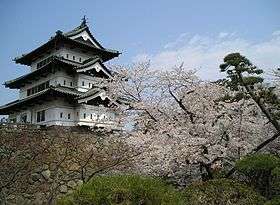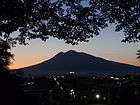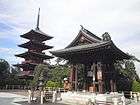Hirosaki
| Hirosaki 弘前市 | |||
|---|---|---|---|
| City | |||
|
| |||
| Hirosaki Castle and Sakura | |||
| Mount Iwaki | Hirosaki Neputa Festival | ||
| Saisho-in temple | former 55 Bank HQ | ||
| |||
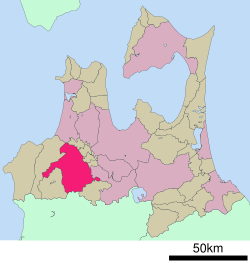 Location of Hirosaki in Aomori Prefecture | |||
 Hirosaki | |||
| Coordinates: 40°36′11.2″N 140°27′49.8″E / 40.603111°N 140.463833°ECoordinates: 40°36′11.2″N 140°27′49.8″E / 40.603111°N 140.463833°E | |||
| Country | Japan | ||
| Region | Tōhoku | ||
| Prefecture | Aomori | ||
| Government | |||
| • Mayor | Hiroshi Sakurada <桜田 宏> (from April 2018) | ||
| Area | |||
| • Total | 524.20 km2 (202.39 sq mi) | ||
| Population (December 1, 2017) | |||
| • Total | 174,171 | ||
| • Density | 330/km2 (860/sq mi) | ||
| Time zone | UTC+9 (Japan Standard Time) | ||
| - Tree | Apple tree | ||
| - Flower | Cherry blossom | ||
| Phone number | 0172-35-1111 | ||
| Address | 1-1 Kamishirogane-machi, Hirosaki-shi, Aomori-ken 036-8551 | ||
| Website | Official website | ||
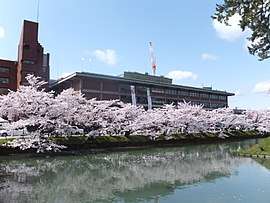
Hirosaki (弘前市 Hirosaki-shi) is a city located in western Aomori Prefecture, Japan. As of 1 December 2017, the city had an estimated population of 174,171 in 71,823 households[1], and a population density of 330 persons per km2. The total area of the city is 524.20 square kilometres (202.39 sq mi).
Hirosaki developed as a castle town for the 100,000 koku Hirosaki Domain ruled by the Tsugaru clan. The city is currently a regional commercial center, and the largest producer of apples in Japan.[2] The city government has been promoting the catchphrase "Apple Colored Town Hirosaki", and "Castle and Cherry Blossom and Apple Town" to promote the city image. The town is also noted for a large number of western-style buildings dating from the Meiji period.
Geography
Hirosaki is located in western Aomori Prefecture, in the Tsugaru plains of southern Tsugaru Peninsula, south of Mount Iwaki and bordering on Akita Prefecture. Mount Iwaki is within the city borders, and the Iwaki River flows through the city.
Neighbouring municipalities
Demographics
Per Japanese census data,[3] the population of Hirosaki has grown slightly over the past 40 years.
| Census Year | Population |
|---|---|
| 1970 | 174,644 |
| 1980 | 192,291 |
| 1990 | 191,217 |
| 2000 | 193,297 |
| 2010 | 183,473 |
City emblem
Hirosaki uses a Buddhist manji (similar in appearance with the swastika) as its official emblem. This came from the flag emblem of Tsugaru clan, the daimyōs of Hirosaki Domain during the Edo period.
Climate
Hirosaki has a cold humid continental climate (Köppen Dfa) characterized by warm short summers and long cold winters with heavy snowfall. The average annual temperature in Hirosaki is 10.1 °C. The average annual rainfall is 1357 mm with September as the wettest month.The temperatures are highest on average in August, at around 23.7 °C, and lowest in January, at around -2.3 °C.[4]
| Climate data for Hirosaki, Aomori (1981–2010) | |||||||||||||
|---|---|---|---|---|---|---|---|---|---|---|---|---|---|
| Month | Jan | Feb | Mar | Apr | May | Jun | Jul | Aug | Sep | Oct | Nov | Dec | Year |
| Average high °C (°F) | 1.5 (34.7) |
2.2 (36) |
6.3 (43.3) |
14.5 (58.1) |
19.8 (67.6) |
23.5 (74.3) |
26.9 (80.4) |
28.9 (84) |
24.5 (76.1) |
18.2 (64.8) |
11.0 (51.8) |
4.5 (40.1) |
15.2 (59.4) |
| Daily mean °C (°F) | −1.8 (28.8) |
−1.3 (29.7) |
1.9 (35.4) |
8.5 (47.3) |
13.8 (56.8) |
17.9 (64.2) |
21.7 (71.1) |
23.5 (74.3) |
18.9 (66) |
12.5 (54.5) |
6.1 (43) |
0.9 (33.6) |
10.2 (50.4) |
| Average low °C (°F) | −5 (23) |
−4.8 (23.4) |
−2.2 (28) |
3.1 (37.6) |
8.3 (46.9) |
13.3 (55.9) |
17.6 (63.7) |
19.1 (66.4) |
14.3 (57.7) |
7.6 (45.7) |
1.8 (35.2) |
−2.4 (27.7) |
5.9 (42.6) |
| Average precipitation mm (inches) | 120.7 (4.752) |
94.5 (3.72) |
77.4 (3.047) |
59.4 (2.339) |
71.8 (2.827) |
69.6 (2.74) |
113.1 (4.453) |
132.1 (5.201) |
127.2 (5.008) |
90.5 (3.563) |
110.0 (4.331) |
116.8 (4.598) |
1,183.1 (46.579) |
| Average snowfall cm (inches) | 248 (97.6) |
208 (81.9) |
131 (51.6) |
11 (4.3) |
0 (0) |
0 (0) |
0 (0) |
0 (0) |
0 (0) |
0 (0) |
20 (7.9) |
142 (55.9) |
760 (299.2) |
| Mean monthly sunshine hours | 57.0 | 78.5 | 126.1 | 183.3 | 201.4 | 175.0 | 160.8 | 181.8 | 146.2 | 141.4 | 89.1 | 58.0 | 1,598.6 |
| Source: Japan Meteorological Agency | |||||||||||||
History
The area around Hirosaki formed part of the domains of the Northern Fujiwara in the Heian period; Minamoto no Yoritomo awarded it to the Nanbu clan in the early Kamakura period after the defeat of the Northern Fujiwara (1189). During the Sengoku period a local retainer of the Nambu, Ōura Tamenobu, declared his independence (1571) and seized local castles. He pledged fealty to Toyotomi Hideyoshi at the Battle of Odawara in 1590, and was confirmed in his holdings with revenues of 45,000 koku. He also changed his name to "Tsugaru". After siding with Tokugawa Ieyasu at the Battle of Sekigahara, he was re-confirmed in his holdings with a nominal kokudaka of 47,000 koku and he began construction of a castle in Takaoka (present-day Hirosaki). This marked the start of Hirosaki Domain under the Tokugawa shogunate. His successor, Tsugaru Nobuhira, completed the castle in 1611, but its massive 5-storey donjon was lost to lightning in 1627. The domain's kokudaka increased to 100,000 koku in 1628.
The Tsugaru clan sided with the Satchō Alliance in the Boshin War of the Meiji Restoration, and was rewarded by the new Meiji government with an additional 10,000 koku. However, with the abolition of the han system on August 29, 1871, Hirosaki Domain was abolished, and replaced by Hirosaki Prefecture. The prefecture was renamed Aomori Prefecture in October of the same year, and the prefectural capital was relocated to the more centrally located Aomori.
Chōyō Elementary School was established on October 1, 1873. Apple horticulture was introduced to Hirosaki from 1877 and the 59th National Bank, the predecessor of Aomori Bank opened in March 1878. Hirosaki was proclaimed a city on April 1, 1889 with the establishment of the modern municipalities system and was thus one of the first 30 cities in Japan. It was also the third largest city in the Tōhoku region after Sendai and Morioka at the time. The Ōu Main Line connected Hirosaki with Aomori on December 1, 1894.
Hirosaki became the home garrison town for the Imperial Japanese Army's IJA 8th Division from October, 1898. The division was prominently active in the Russo-Japanese War.
Hirosaki City Hospital was established in 1901, and Hirosaki City Library in 1906. The first telephone service in the city stated from 1909. The first Cherry Blossom Festival was held in 1918. In 1927, the Kōnan Railway connected Hirosaki with Onoe. Hirosaki University was established in 1949.
On March 1, 1955, Hirosaki expanded through annexation of neighboring villages of Shimizu, Wattoku, Toyoda, Horikoshi, Chitose, Fujishiro, Niina, Funazawa, Takasugi, Susono and Higashimeya. Nishimeya became an enclave. The city further expanded on September 1, 1957, through annexation of neighboring Ishikawa Village.
The first Chrysanthemum and Maple Festival took place in 1964, and the first Hirosaki Castle Snow Lantern Festival in 1977. In 1979, the city was connected to the Tōhoku Expressway by a spur road named "Apple Road".
On November 15, 2006, old Hirosaki city, the town of Iwaki, and village of Sōma were merged into the new and expanded city of Hirosaki.
Government
Hirosaki has a mayor-council form of government with a directly elected mayor and a unicameral city legislature of 28 members. The city, together with the neighbouring village of Nishimeya, contributes six members to the Aomori Prefectural Assembly.
Economy
Hirosaki is the regional commercial center for southwest Aomori Prefecture. The main agricultural crops include apples and rice, with Hirosaki accounting for 20% of the total production of apples in Japan.
Education
Colleges and universities
Primary and secondary education
Hirosaki has 36 public elementary schools and 15 public junior high schools operated by the city government. There is one national public elementary school and public junior high school, and one private combined elementary/junior high school and one private junior high school. The city also has six public high schools operated by the Aomori prefectural Board of Education and four private high schools.
Public high schools
- Hirosaki High School
- Hirosaki Chūō High School
- Hirosaki Minami High School
- Hirosaki Vocational High School
- Hirosaki Technical High School
Private high schools
- Tōōgijuku High School
- Hirosaki Gakuin Seiai Middle and High School
- Shibata Girls' High School
- Hirosaki Higashi High School
Other schools
Hirosaki has four special education schools, three of which are operated by Aomori Prefecture, and one by the national government.
Transportation
Railways
Highways
Sports
Sports teams
- Blancdieu Hirosaki FC, football team
Culture
- Tsugaru-jamisen, a virtuosic style of shamisen playing.
- Hirosaki Neputa Festival, held during the first week of August and is one of the 100 Soundscapes of Japan by the Ministry of the Environment [5]
- Cherry Blossom Festival held in the park surrounding Hirosaki Castle. About 2,600 Sakura (Japanese cherry) blossom during the Japanese Golden Week vacation period.
Local attractions
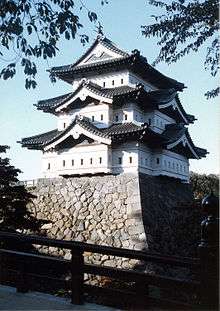
- Hirosaki Castle
- Hirosaki Tōshō-gū
- Nakamachi Bukeyashiki
- Chosho-ji
- Saishō-in
- Fujita Memorial Japanese Garden
- Ōmori Katsuyama Site, National Historic Site
Noted people from Hirosaki
- Hisashi Tonomura, musician
- Iwakiyama Ryūta, sumo wrestler
- Yōjirō Ishizaka, writer
- Norio Kudo, professional go player
- Mitsuyo Maeda, judo wrestler
- Juji Nakada, evangelist
- Yoshitomo Nara, modern artist
- Takanohana Kenshi, sumo wrestler
- Shūji Terayama, modern artist
- Wakanohana Kanji I, sumo wrestler
- Wakanosato Shinobu, sumo wrestler
- Shunsuke Kikuchi, musician
References
- ↑ Hirosaki official home page (in Japanese)
- ↑ Hirosaki Tourism and Convention Bureau
- ↑ Hirosaki population statistics
- ↑ Hirosaki climate data
- ↑ "100 Soundscapes of Japan". Ministry of the Environment. Retrieved 8 December 2015.
External links
| Wikimedia Commons has media related to Hirosaki. |
| Wikisource has the text of the 1905 New International Encyclopedia article Hirosaki. |
| Wikivoyage has a travel guide for Hirosaki. |
- Official website (in Japanese)
